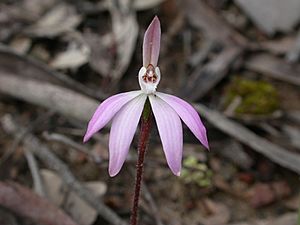Dusky fingers facts for kids
Quick facts for kids Dusky fingers |
|
|---|---|
 |
|
| C. fuscata growing on Black Mountain in the Australian Capital Territory | |
| Scientific classification | |
| Genus: |
Caladenia
|
| Species: |
fuscata
|
| Synonyms | |
|
|
Caladenia fuscata, commonly known as dusky fingers, is a plant in the orchid family. It grows naturally only in eastern and south-eastern Australia, including Tasmania. This small ground orchid is often found in eucalyptus woodlands. It usually flowers in September and October.
Contents
What Does Dusky Fingers Look Like?
Dusky fingers is a plant that grows from an underground storage part called a tuber. It's a perennial plant, meaning it lives for more than two years. Each plant has one long, thin leaf that is about 5 to 18 centimeters (2 to 7 inches) long. This leaf has a few hairs on it.
The Flower of Dusky Fingers
Each plant usually produces a single flower on a stem up to 15 centimeters (6 inches) tall. The flower can be white or pink.
- The top part of the flower, called the dorsal sepal, stands straight up. It is about 7 to 12 millimeters (0.3 to 0.5 inches) long.
- The side sepals and petals are usually 6 to 12 millimeters (0.2 to 0.5 inches) long. They have a band of short, reddish-brown hairs on their outer surfaces.
- The most interesting part is the labellum, which is the orchid's special lip. It is shaped like an egg, about 6 millimeters (0.2 inches) long and wide. It can be white or pinkish and has clear red stripes.
- The labellum has three parts, or lobes. The middle lobe is small and pointed. It has tiny teeth along its edge. There are also rows of yellow-tipped structures called calli in the center.
- The side lobes are bigger and stick out past the middle lobe.
- The column is a central part of the flower, about 5 to 7 millimeters (0.2 to 0.3 inches) long. It curves inward and has narrow wings.
Dusky fingers flowers in September and October. After flowering, it forms a dry seed pod called a capsule. This capsule opens up to release many tiny seeds.
How to Tell it Apart from Similar Orchids
Dusky fingers looks a bit like another orchid called Caladenia carnea. However, you can tell them apart because dusky fingers usually has only one flower. It also flowers earlier in the year. Plus, it has distinct red stripes on its labellum and column, which Caladenia carnea does not.
How Dusky Fingers Got Its Name
Caladenia fuscata was first officially described in 1871 by a scientist named Heinrich Gustav Reichenbach. At first, he thought it was just a type of Caladenia carnea. Later, in 1989, two other scientists, David Jones and Mark Clements, decided it was different enough to be its own species.
The second part of its scientific name, fuscata, comes from the Latin word fusca. This word means "brown." It refers to the brownish color found on the back of the sepals and petals of the flower.
Where Dusky Fingers Grows
Dusky fingers can be found in several Australian states: Queensland, New South Wales, Victoria, Tasmania, and South Australia. It grows in different types of places, including open forests, woodlands, and coastal scrub areas. It can grow in various soil types.
Most often, you will find dusky fingers on the drier western side of the Great Dividing Range in Australia. It has also been seen growing in New Zealand.


